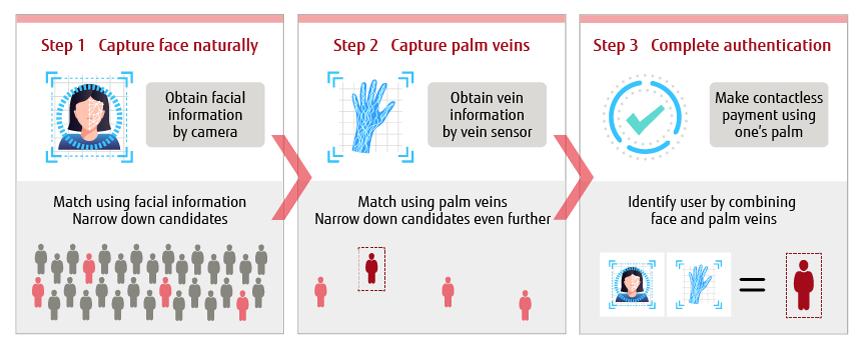Contactless Biometric Authentication Technology for Smart Customer Experiences
Release date: June 30, 2021
The recent spread of the novel coronavirus (COVID-19) is generating a growing need for contactless and non-face-to-face services. In response to this need, the introduction of biometric authentication technology is being actively studied as a means of providing secure and highly convenient services even without face-to-face interaction. This article describes existing problems with contactless biometric authentication in the “new normal” era and innovative technologies for solving those problems along with examples of collaborations with retail businesses. It also introduces the idea of a “Connected World with biometric authentication” spanning a variety of services.
- 1. Introduction
- 2. Expectations of retail industry towards biometric authentication
- 3. Fujitsu technical innovation in biometric authentication
- 4. Expanding the use of biometric authentication applications
- 5 .Conclusion
1. Introduction
In 2020, the COVID-19 pandemic brought great changes to our individual way of living. There is an increasing need for solutions that are “remote” or “full self-service” that will free users from meeting each other or touching things, all of which we had taken for granted. The results of a survey showed changes in user awareness with 79.8% of people becoming uneasy about touching things after the “corona shock” [1].
Turning to retail businesses, existing initiatives are taking on new importance in the light of the COVID-19 pandemic. These include the move to cashless payments with the aim of reducing the cost of cash management at registers and work-style reform that aims to save on labor without degrading productivity in a time of labor shortages. Such trends are gaining attention as solutions that can solve these new problems by reducing opportunities for contact within stores and providing both users and employees a safe and secure environment. The creation of new types of stores to meet these needs is accelerating the digital transformation (DX) of retail businesses.
In this article, we describe biometric authentication technology for achieving hygienic, contactless, and non-face-to-face services along with application examples in the retail industry. We also introduce the idea of a “Connected World with biometric authentication” spanning a variety of industries and services.
2. Expectations of retail industry towards biometric authentication
In the retail industry, stores that are dealing with labor shortages and working to adapt to the new normal era have a growing need for unmanned and labor-saving measures to provide services with no human intermediary and reduce occasions of close contact among people. At the same time, there are concerns of a decline in security due to lack of visual monitoring by people. In short, there is a need for solutions that can provide both high productivity and security along with labor savings. The use of biometric authentication technology has been attracting attention as a means of achieving these solutions.
First, biometrics can be applied to cashless payment or age verification to achieve high productivity. Specifically, payment information such as credit-card or loyalty-card numbers can be tied to biometric information to achieve cashless and cardless payments with biometric authentication. In this way, it is anticipated that the ability to make purchases without having to carry anything in particular will increase patronage and sales. The convenience store industry, meanwhile, is conducting studies on tying date of birth included on a person’s ID card to biometric authentication to achieve cardless and reliable age verification.
Next, biometrics can be applied to physical access such as passing through an entrance gate to achieve a high degree of security.
3. Fujitsu technical innovation in biometric authentication
This section takes up problems faced by retail businesses in applying biometric authentication to a large number of users and to new normal stores and describes innovative Fujitsu technologies for solving those problems together with application examples.
Fujitsu has equipped personal computers, smartphones, ATMs, and other devices with various types of biometric authentication for personal identification using biometric information such as a fingerprint, iris, face, or palm veins. In particular, palm vein authentication that features high authentication accuracy and safety making impersonation difficult is being rolled out as Fujitsu PalmSecure palm vein authentication![]() (hereafter, PalmSecure) in services targeting general users. PalmSecure can be used, for example, for personal identification when using ATMs and libraries and passenger identification at airports.
(hereafter, PalmSecure) in services targeting general users. PalmSecure can be used, for example, for personal identification when using ATMs and libraries and passenger identification at airports.
PalmSecure enables authentication to be performed by having the user explicitly hold his or her palm over a sensor. In other words, authentication can be carried out only if the user intends to do so and not by some sort of automatic or hidden process. This approach has the effect of removing any concerns about “authentication being performed without my permission.” In services that target general users, being able to select and use a service in a worry-free manner is desirable for creating a high degree of acceptance. PalmSecure, which has been used successfully by more than 94 million in about 60 countries around the world, is a technology applicable to services targeting general users.
In retail businesses, PalmSecure is already being used as a means of achieving reliable palm-based personal identification without placing a burden on the user in applications like facility access (member management) and cashless and cardless payments.
However, the expansion of usage scenarios due to the COVID-19 pandemic has created technical issues that need to be solved. For example, identification cannot be achieved for a large number of users on a scale of several tens of thousands with only one type of biometric authentication at the present level of accuracy. In addition, some sort of physical guide is needed to accurately capture the veins in a person’s palm.
3.1 Multi-Factor Biometric Authentication for high-speed authentication on a scale of 1 million users
Identifying an individual with only one type of biometric authentication is limited due to problems associated with accuracy and speed of authentication. Even with PalmSecure having high authentication accuracy, the upper limit in terms of number of users is generally held to be 10,000 people (5,000 people when enrolling the palms of both hands). Consequently, if the number of users should exceed 10,000, it is recommended that users also enter a key such as a telephone number or birthdate to narrow down the number of candidates for authentication. However, key input is a task that places a burden on users while also being an occasion of contact, so there are some in the retail industry, which tends to place importance on speed and usability, who are saying that key input would be difficult for users to accept. Against this background, we developed Multi-Factor Biometric Authentication Technology that combines facial authentication, which can authenticate a user by natural, user-friendly actions, and PalmSecure, which features high accuracy [2].
As shown in Figure 1, Step 1 narrows down the number of candidates targeted for authentication to less than 10,000 people from all enrolled data by capturing and using a facial image while the user holds his or her hand over the sensor. Here, a low false rejection rate that can retrieve the target user with a high search ranking is needed. Next, Step 2 performs palm vein authentication against the authentication candidates extracted by facial authentication and Step 3 identifies the user. At this time, a single person must be reliably identified, so a low false acceptance rate is important. This Multi-Factor Biometric Authentication Technology selects face and palm veins considering not only ease of use but also accuracy that takes on importance in each processing step.

Figure 1 Multi-Factor Biometric Authentication Technology.
While combining multiple types of biometric authentication makes large-scale authentication possible, increase in the time needed for authentication processing is still a problem. In particular, the increase in processing time when referencing a database at the time of authentication creates a bottleneck thereby degrading usability. To solve this problem, we decided to use an in-memory database to speed up query and load processing times. In this way, we achieved Multi-Factor Biometric Authentication that could perform high-speed authentication equivalent to single-factor biometric authentication on a scale of 1 million users.
At present, Fujitsu is conducting field trials toward practical use of Multi-Factor Biometric Authentication at a cash register-free Lawson Go store inside Fujitsu’s Shin-Kawasaki office in cooperation with Lawson Inc. [3] and at a KOYO SHOP-PLUS cash register-free store for general customers [4].
These field trials are introducing Multi-Factor Biometric Authentication in cash register-free stores as a means of personal identification at the store entrance to ensure sufficient security even in unmanned stores. The absence of cash registers effectively reduces checkout wait time while also making it unnecessary to pull out one’s purse or smartphone or launch a smartphone app. As a result, the average wait time consists only of the time taken for identification on entering the store, which comes down to about four seconds. This method takes one-third the time of the current store-entering method in which customers hold the QR code displayed on the Lawson Go smartphone app over a scanner and has the effect of shortening the checkout wait time at conventional manned stores with cash registers by 90%.
3.2 Learning engine for identifying even masked users takes 1st place in accuracy amongst Japanese vendors
In facial authentication, most of the face is covered when wearing a mask resulting in a significant drop in accuracy. It has therefore become common in facial authentication when a mask is worn to use only those parts of the face not hidden by the mask, that is, the features extracted from the area around the eyes. In this case, however, the area of the facial image used for extracting features becomes smaller, which means a reduction in the amount of information and a greater chance of an authentication failure. As a consequence, there are times under this method in which the user’s mask has to be temporarily removed to complete the authentication process.
To enable comfortable authentication even for a COVID-19 mask-wearing lifestyle, we developed an engine for learning facial image information by artificially adding a mask image to an ordinary facial image without a mask. The concept behind this engine is shown in Figure 2. This engine achieves high accuracy by extracting feature points using information other than that around the eyes such as facial contour, shape, etc. In the past, the failure rate in narrowing down the number of candidates based on mask-wearing faces stood at several percent, but this technology has been found to lower this failure rate to less than one percent. This technology also took first place in authentication accuracy among Japanese vendors in the Face Recognition Vendor Test (FRVT) conducted by the National Institute of Standards and Technology (NIST) in the United States in which more than 160 organizations from around the world participated [5].

Figure 2 Data-expansion learning technology.
3.3 Improved UI for achieving totally physical-guide-free palm vein authentication
PalmSecure is contactless authentication technology using vein patterns obtained by holding one’s palm over a sensor. This technology is especially hygienic, but users who are not accustomed to suspending one’s palm in the air for authentication purposes may find it difficult to understand the appropriate height above the sensor to enable authentication.
In response to this problem, we developed an improved user interface (UI) based on light induction. In this UI, light in the shape of a palm appears around the sensor and the color and emission pattern of this light changes according to the height of the user’s hand above the sensor. This approach enables the user to develop an intuitive understanding of the appropriate height for authentication. As shown in Figure 3, changing the color of this light in real time according to palm height enables the user to grasp the appropriate height while keeping an eye on his or her hand, which makes for a comfortable authentication experience.

Figure 3 Improved UI.
This improved UI and facial-authentication learning engine described in the previous section have been undergoing evaluation and testing since January 2021 at the Lawson Go field trial inside Fujitsu’s Shin-Kawasaki office.
4. Expanding the use of biometric authentication applications
In the retail industry, there have been areas in which opening a conventional manned store has been difficult due to revenue, space, or other issues. Cash register-free solutions with enhanced security by biometric authentication as in “Lawson Go” convenience stores can enable expansion into such areas even with a labor shortage. There are also plans for a “Connected World with biometric authentication” that would enable wide-area expansion of palm-based authentication services by linking one-time enrolment of biometric information with various types of service IDs. This could be accomplished by using FUJITSU Security Solution AuthConductor![]() as an intermediary to share biometric information with public services like local government and healthcare and groups that roll out services for general users. An expansion of services that use biometric authentication in this way would not only provide users with more convenient services but also enable a large volume of usage data to be collected using biometric authentication as a key. We can therefore expect a “Connected World with biometric authentication” to bring a rise in data quality as well as a rise in the quality of personalized services.
as an intermediary to share biometric information with public services like local government and healthcare and groups that roll out services for general users. An expansion of services that use biometric authentication in this way would not only provide users with more convenient services but also enable a large volume of usage data to be collected using biometric authentication as a key. We can therefore expect a “Connected World with biometric authentication” to bring a rise in data quality as well as a rise in the quality of personalized services.
5. Conclusion
This article described biometric authentication technology and its application using as examples retail businesses that wish to create “new normal” stores.
To create even more use cases, this technology and related UIs must be easy for users to understand and to use without worry. Going forward, we plan to make further enhancements to biometric authentication such as improving usability and accuracy and to provide novel customer experiences based on new types of biometric authentication.
All company and product names mentioned herein are trademarks or registered trademarks of their respective owners.
References and Notes
About the Authors

Ms. Okutaki is engaged in sales promotion of PalmSecure palm vein authentication technology.

Mr. Abe is engaged in the research and development of palm vein authentication technology, facial authentication technology, and Multi-Factor Biometric Authentication Technology.

Mr. Matsuyama is engaged in the research and development of biometric authentication systems.

Mr. Yamada is engaged in the research and development of palm vein authentication technology, facial authentication technology, and Multi-Factor Biometric Authentication Technology.
